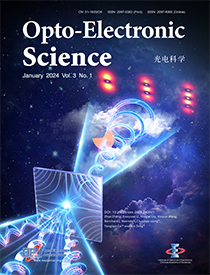2024 Vol. 3, No. 1
Cover story: Zhang Z, Li GY, Liu YL et al. Robust measurement of orbital angular momentum of a partially coherent vortex beam under amplitude and phase perturbations. Opto-Electron Sci 3, 240001 (2024).
In the realm of free-space optical communication, vortex beams which possess orbital angular momentum (OAM) emerges as a transformative paradigm, which brings us the possibility to significantly increase communication capacity. However, during the transmission process, the beam is easily affected by perturbations such as atmospheric turbulence, introducing distortions in their topological structure, and crosstalk between OAM modes, limiting its ability to transmit information. Partially coherent beams stand as an effective solution to resist the negative effects caused by turbulent atmosphere or obstacles in the transmission path. Partially coherent vortex light fields with both OAM and partially coherence properties have shown unique advantages in fields such as beam shaping, ghost imaging, optical communications, and information encryption. Despite this, in the field of long-distance information transmission, the pursuit of robust transmission and detection of OAM information of partially coherent vortex light fields in complex environments still encounters formidable obstacles.
Presenting the core principles of OAM robust detection technology, we introduce an innovative cross-phase control methodology designed to accurate extract OAM information of partially coherent vortex beams in complex environments, solving the issues such as information loss induced by the destruction of the spatial-coherence structure. The cross-phase enables the OAM/ topological charge information hidden in the spatial-coherence structure can be stably transmitted to the far field and emerge as a distribution with multiple isolated dark rings. The number of separated dark rings is equal to the magnitude of the topological charge which determines the OAM carried by each photon in the vortex beam. The sign of topological charge is determined by the arrangement direction of separated dark rings. Remarkably, this method is not only suitable for detection in free space transmission environments, but also for detection in transmission environments with obstructions and atmospheric turbulence disturbances. This is because the improvement in self-healing property induced by the cross-phase is enough to resist the adverse effects caused by complex environments. This research method and results have potential application value in optical information encryption and free-space optical communications in complex environments.

-
{{article.year}}, {{article.volume}}({{article.issue}}): {{article.fpage | processPage:article.lpage:6}}. doi: {{article.doi}}{{article.articleStateNameEn}}, Published online {{article.preferredDate | date:'dd MMMM yyyy'}}, doi: {{article.doi}}{{article.articleStateNameEn}}, Accepted Date {{article.acceptedDate | date:'dd MMMM yyyy'}}CSTR: {{article.cstr}}
-
{{article.year}}, {{article.volume}}({{article.issue}}): {{article.fpage | processPage:article.lpage:6}}. doi: {{article.doi}}{{article.articleStateNameEn}}, Published online {{article.preferredDate | date:'dd MMMM yyyy'}}, doi: {{article.doi}}{{article.articleStateNameEn}}, Accepted Date {{article.acceptedDate | date:'dd MMMM yyyy'}}CSTR: {{article.cstr}}

 E-mail Alert
E-mail Alert RSS
RSS


